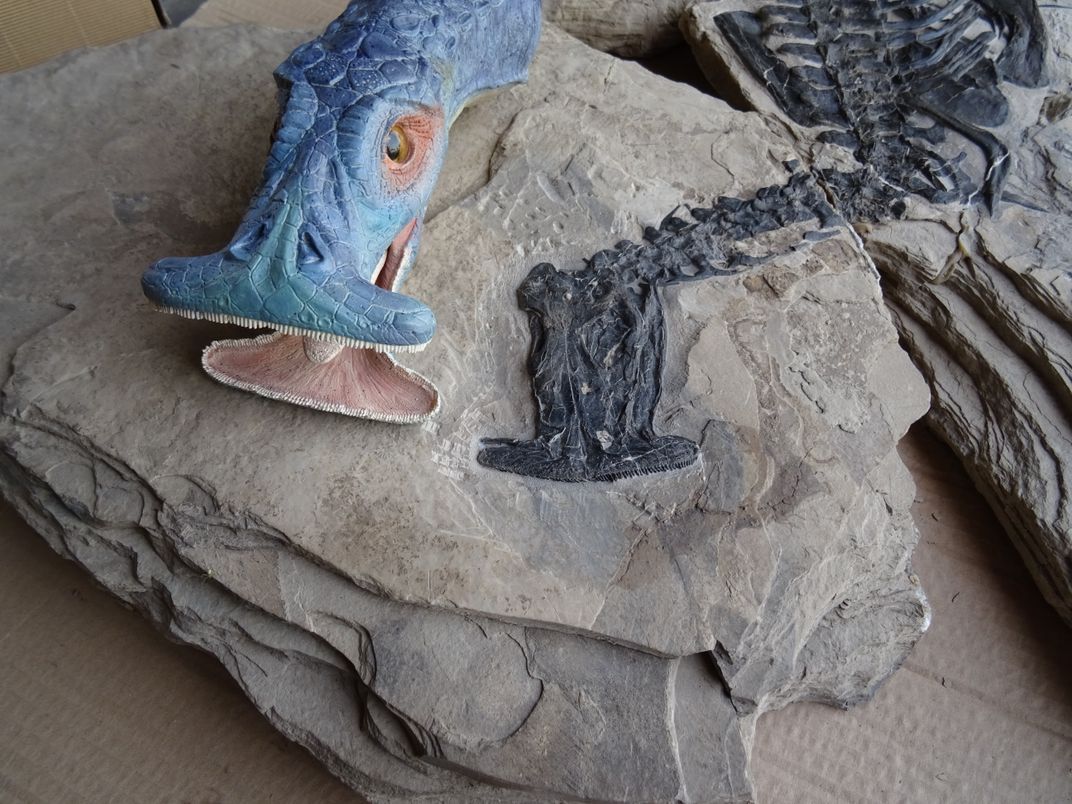Weirdo Ancient Marine Reptile Had a Vacuum-Shaped Head
Animal probably slurped up plant material from the seafloor
/https://tf-cmsv2-smithsonianmag-media.s3.amazonaws.com/filer/b3/98/b3982003-b6e8-4fdd-aa6d-122669e38e7b/hammerhead_complete.jpg)
Paleontologists knew that Atopodentatus was strange from the moment they set eyes on it. The 10-foot-long, 245-million-year-old reptile, whose remains were found in southwest China and described in 2014, seemed to have a skull shaped like a tape dispenser and tipped with a strange zipper of needle-like teeth that presumably helped the oddball sift plankton from ancient mud. But interpretations of the prehistoric past can pivot on a single fossil, and two new Atopodentatus skeletons have shown that this seagoing weirdo was even more unusual than originally thought.
The narrow “zipper” of the first specimen was actually a distortion created by the fossil record, paleontologist Olivier Rieppel of the Chicago Field Museum and colleagues show in a recent study in Science Advances.
“In the first specimen,” Rieppel says, “the skull was partially disarticulated, and the upper jaw bones were preserved in a position suggesting a strongly downturned rostrum,” or snout. The new fossils show the proper positions of these bones. It turns out that this marine reptile was one of the Earth’s earliest hammerheads; its jaws swing out sideways, making the reptile’s head look like a vacuum cleaner attachment.

But how did such a strange creature feed itself? Atopodentatus was initially thought to sieve mud through its teeth to catch tiny crustaceans, much like gray whales do today, but the new fossils reminded Rieppel and colleagues of another, distantly related marine reptile called Henodus that is thought to have been an herbivore. This raised the possibility that Atopodentatus, too, may have primarily been a vegetarian.
With the help of some clay models to see how the jaws and teeth locked together, Rieppel and his team reconstructed how Atopodentatus might have fed. The animal’s vacuum-shaped skull, it seems, indicates more than just a coincidence with the common suction technology.
The animal’s mouth, the paleontologists report, acted in a scraper-suction combo that must have made this animal’s behavior look as strange as its anatomy. After using its jaws to scratch up algae or other plant matter, Rieppel says, “the animal needed to create a suction force by rapidly opening its broad mouth so that the loose plant material would be sucked in.” At that point, he adds, “closing the mouth and putting the tongue to good use, the water was then expelled from the mouth while the plant material would be filtered by the needle-like teeth.” Think about that the next time you need to break out the attachments to clean the couch.
This not only makes Atopodentatus unexpectedly strange but also marks the animal as the earliest-known herbivore in the history of marine reptiles—a tradition carried on by marine iguanas in the Galapagos today.
Moreover, the time at which Atopodentatus lived makes this animal a critical part of life’s greatest comeback.
Atopodentatus lived between 247 and 242 million years ago—10 million years or less after the worst mass extinction of all time wiped out some 90 percent of known species in the seas and 70 percent on land. There was “a pretty complex food web” in the ocean by this time, Rieppel says, meaning that life had come roaring back after being reduced so severely. Atopodentatus can thus be considered a marker of when the oceans had recovered from this catastrophe and became hosts to bizarre herbivores, sea monster-like carnivores that specialized on large prey, fish-eaters with ludicrously-long necks and other forms.
/https://tf-cmsv2-smithsonianmag-media.s3.amazonaws.com/accounts/headshot/RileyBlack.png)
/https://tf-cmsv2-smithsonianmag-media.s3.amazonaws.com/accounts/headshot/RileyBlack.png)